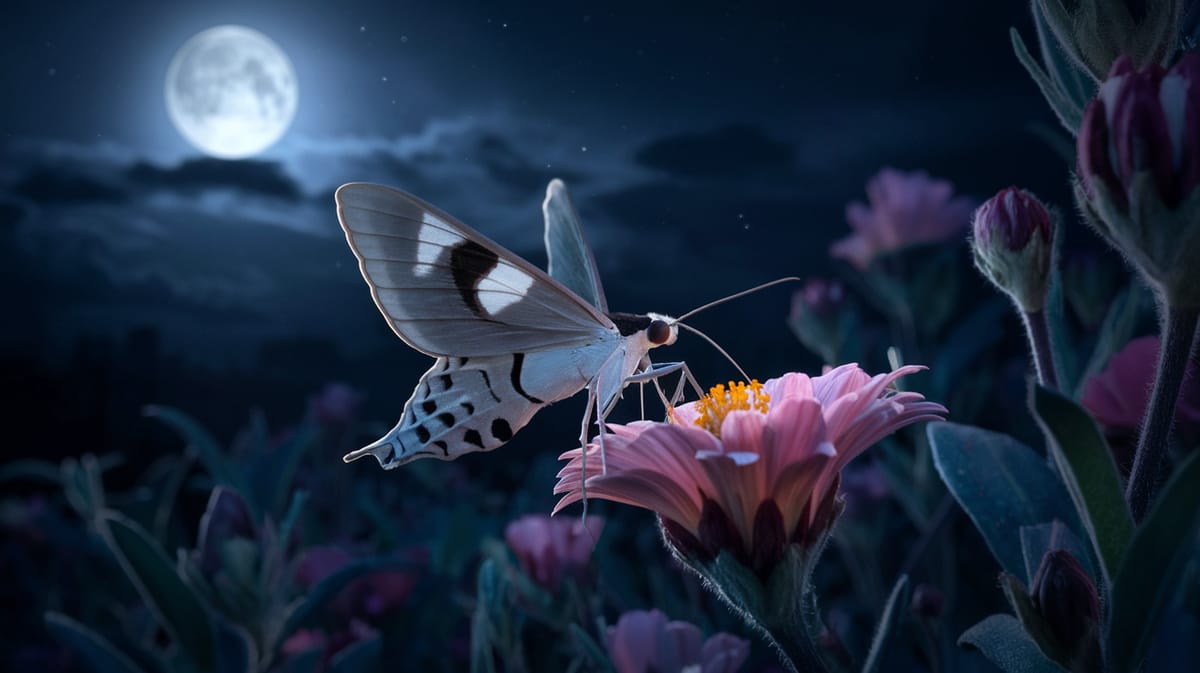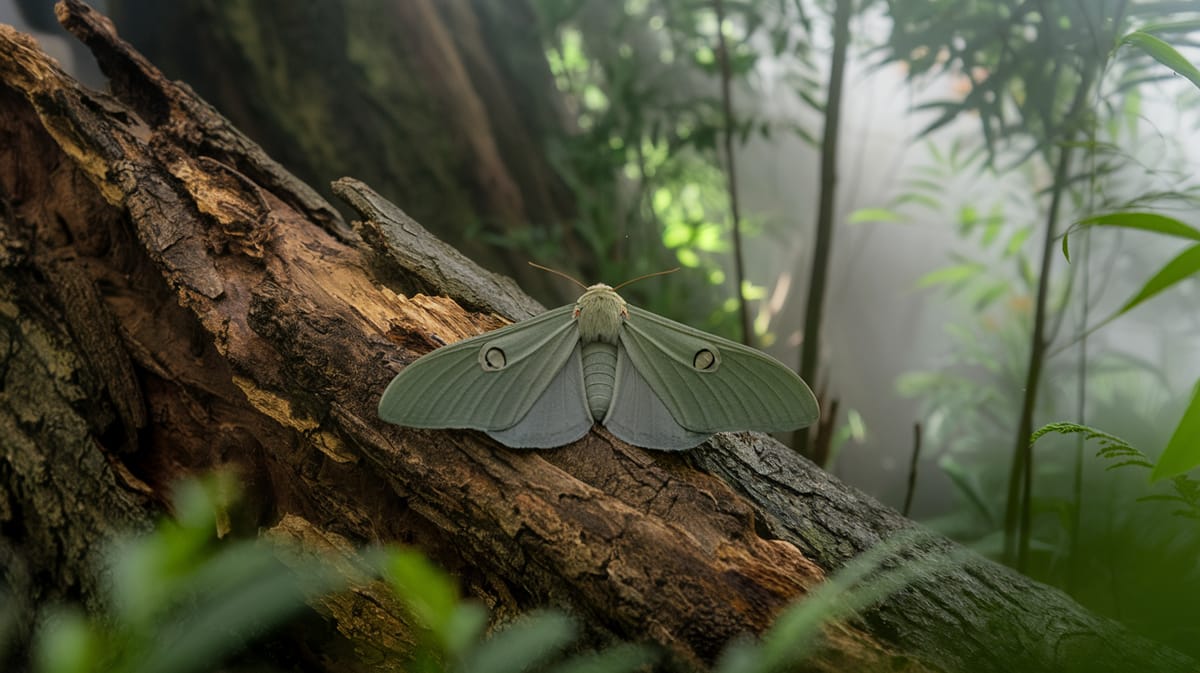Death's-head Hawkmoth
Iconic for its skull-like marking and eerie squeak, the Death's-head Hawkmoth fascinates with its nocturnal flights and ability to infiltrate beehives undetected. Its presence enriches ecosystems by pollinating night-blooming flowers.

Key Insights at a Glance
Did You Know?
Taxonomy & Classification
Death's-head Hawkmoths are known for their striking skull-like markings and ability to emit a unique squeaking sound, reflecting fascinating evolutionary adaptations. Let's understand the evolutionary journey and classification of these remarkable pollinators.
Global Distribution
Found across Europe, Asia, and Africa, Death's-head Hawkmoths display a wide distribution, showcasing their adaptability to diverse climates.
Evolutionary Resilience
Originating during the Eocene epoch, these moths have survived climatic changes, highlighting their evolutionary resilience and adaptability.
Lifecycle and Growth
A remarkable journey of transformation from Egg to Adult.
Egg
Eggs are laid singly on host plants, providing nutrition and protection until larvae emerge, ready to start feeding.
Larva
Larvae undergo five molts, growing rapidly while feeding on leaves, displaying a distinctive horn on their rear end.
Pupa
Pupation occurs underground, where the transformation into an adult moth takes place in a secure cocoon.
Adult
Adults have a striking skull pattern on their thorax and can emit a squeak, mainly feeding on honey.
Dietary Habits
A nocturnal nectar feeder with unique adaptations, this insect mainly consumes honey, occasionally raiding bee hives for sustenance.
| DIET TYPE | DESCRIPTION |
|---|---|
| Primary Diet | Primarily feeds on nectar and honey, using its proboscis to access floral and hive resources. |
| Secondary Diet | Occasionally consumes tree sap and overripe fruit, supplementing its diet with additional sugars and nutrients. |
| Occasional | Rarely ingests pollen or other plant secretions, adapting to resource availability in its environment. |

Behaviour and Adaptations
Discover the intriguing adaptations of the Death's-head Hawkmoth that ensure its survival in diverse environments.
Skull-like Markings
Unique skull pattern on thorax deters predators by mimicking a larger threat.
Mimicry Sound
Emits bee-like sounds to confuse and blend with bees when raiding hives.
Scent Secretion
Releases chemical scent matching bees, aiding in hive infiltration without detection.
Ecosystem Impact
Supporting ecosystem sustainability through the unique roles of the Death's-head Hawkmoth.
Nocturnal Pollinator
Pollinates night-blooming flowers, enabling plant reproduction and genetic diversity.
Nutrient Recycler
Feeds on decaying organic matter, aiding in nutrient cycling and soil health.
Predator Prey Dynamics
Serves as prey for birds and bats, maintaining balance in food webs.
Conservation Challenges
Understanding and addressing the major threats to Death's-head Hawkmoth populations.
Habitat Loss
Deforestation and agriculture reduce available habitats for moths.
Pesticide Use
Intensive pesticide use harms moth larvae and adults.
Climate Change
Altered weather patterns disrupt migration and breeding cycles.
Frequently Asked Questions
How long do Death's-head Hawkmoth live?
Death's-head Hawkmoths typically live for about six weeks as adults. Their lifespan includes stages as eggs, larvae, and pupae, with the entire lifecycle taking several months.
What do Death's-head Hawkmoth eat?
As adults, Death's-head Hawkmoths primarily feed on honey, which they obtain by raiding beehives. The larvae feed on a variety of plants, notably those in the nightshade family, such as potatoes and tomatoes.
Are Death's-head Hawkmoth poisonous?
Death's-head Hawkmoths are not poisonous. They pose no threat to humans or pets, as they do not produce toxins nor do they sting or bite.
Are Death's-head Hawkmoth endangered?
Death's-head Hawkmoths are not currently listed as endangered. They are widespread across Europe and parts of Asia and Africa. Their population is stable, and they are not considered at risk.
What do Death's-head Hawkmoth symbolize?
Death's-head Hawkmoths often symbolize mystery, transformation, and the unknown due to their striking appearance and skull-like marking on their thorax. They have appeared in various cultural references, adding to their enigmatic allure.
Do Death's-head Hawkmoth bite?
Death's-head Hawkmoths do not bite. They are harmless to humans and animals, lacking both biting and stinging capabilities.
What color are Death's-head Hawkmoth?
Death's-head Hawkmoths are primarily dark brown or black with orange and yellow markings. The most distinctive feature is the skull-like pattern on their thorax, giving them their unique name.
Does a Death's-head Hawkmoth have wings?
Yes, Death's-head Hawkmoths have wings. They are large and robust moths with a wingspan ranging from 4 to 5 inches (10 to 13 cm), allowing them to fly efficiently.
What does a Death's-head Hawkmoth look like?
Death's-head Hawkmoths are large and robust, with a wingspan of 4 to 5 inches. They have a distinctive skull-like marking on their thorax, dark wings with orange-yellow bands, and a stout body.
Is a Death's-head Hawkmoth an insect?
Yes, a Death's-head Hawkmoth is an insect. It belongs to the order Lepidoptera, which includes butterflies and moths, and is known for its distinctive skull-like marking on the thorax.
Related Insects
Discover insects with similar characteristics to Death's-head Hawkmoth - including shared habitats, diets, and taxonomic classifications
Share this profile
Help others discover Death's-head Hawkmoth
